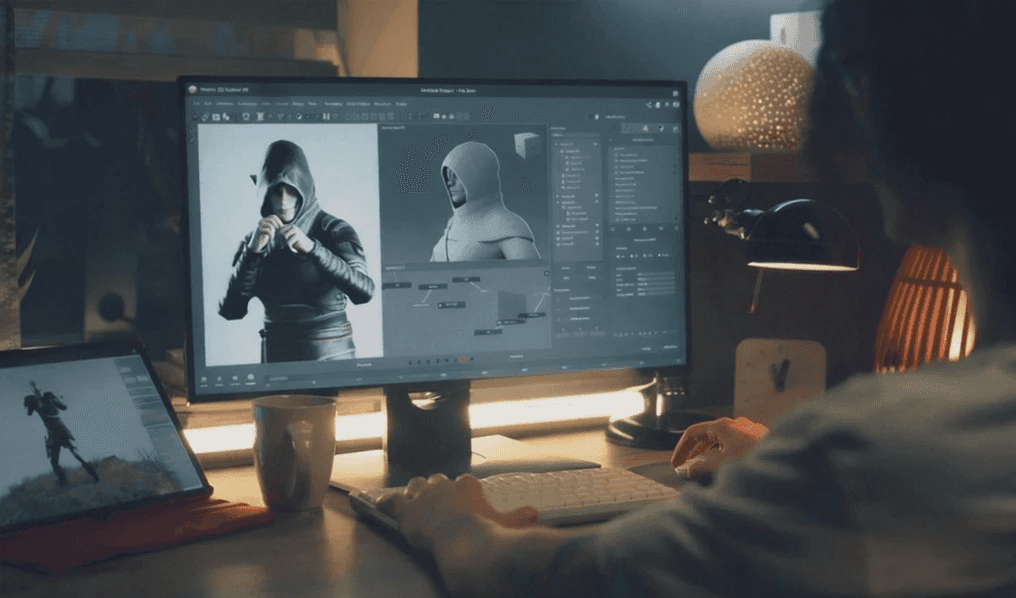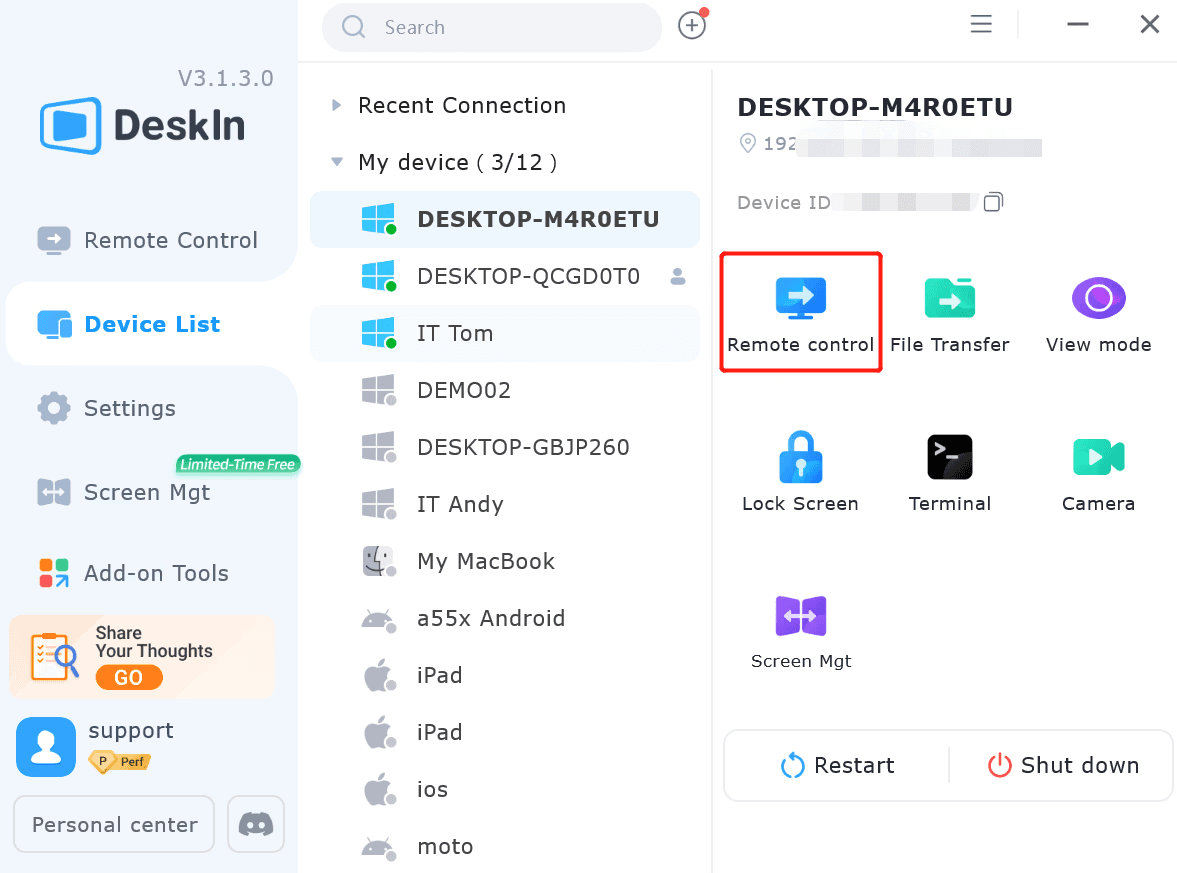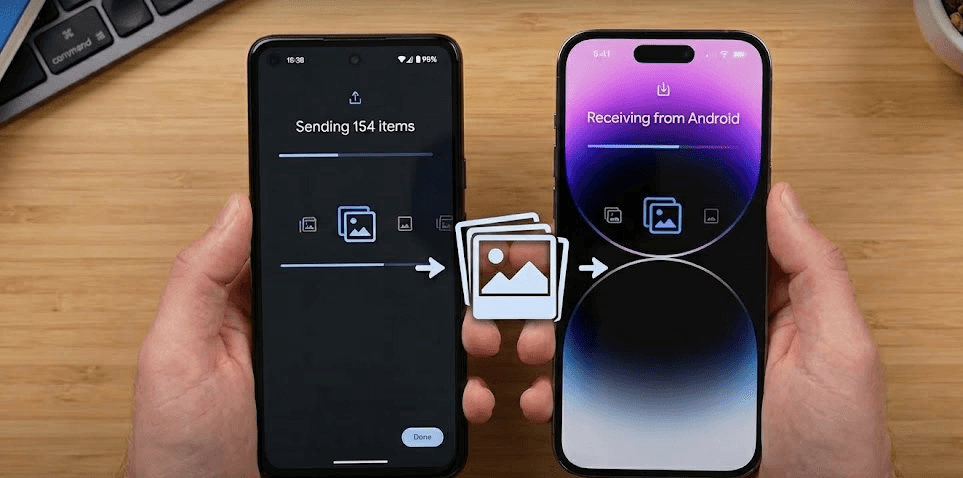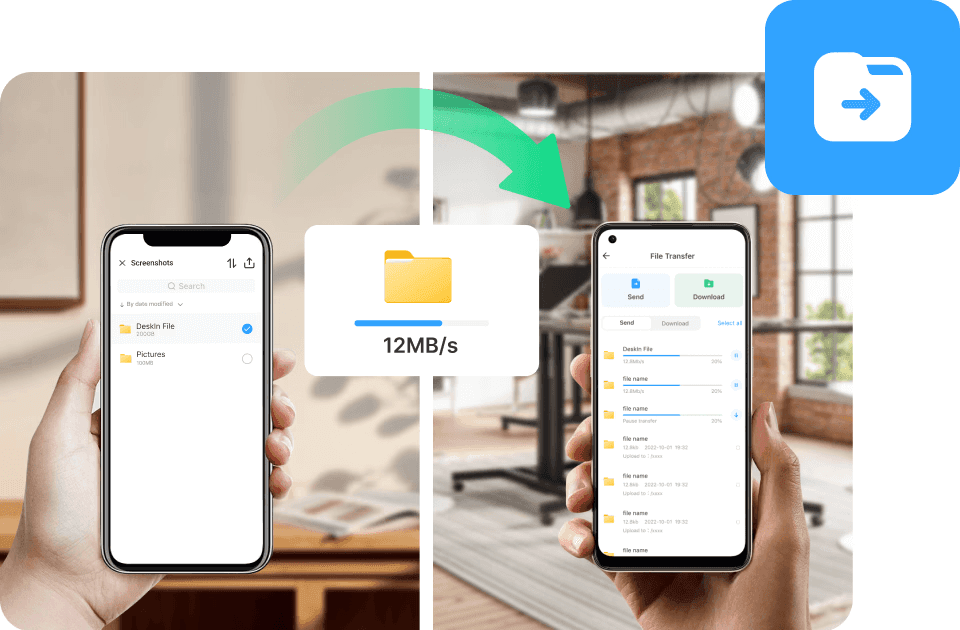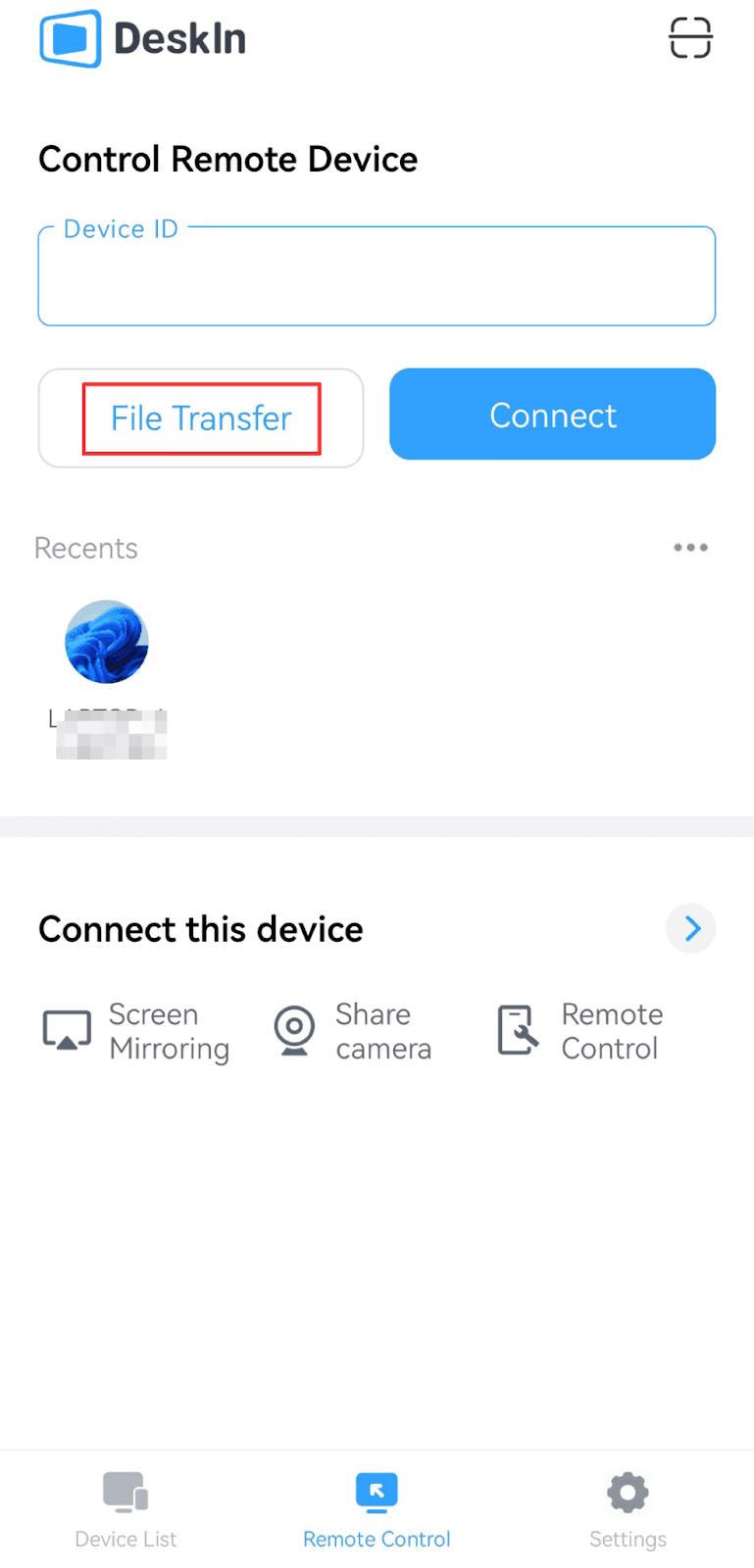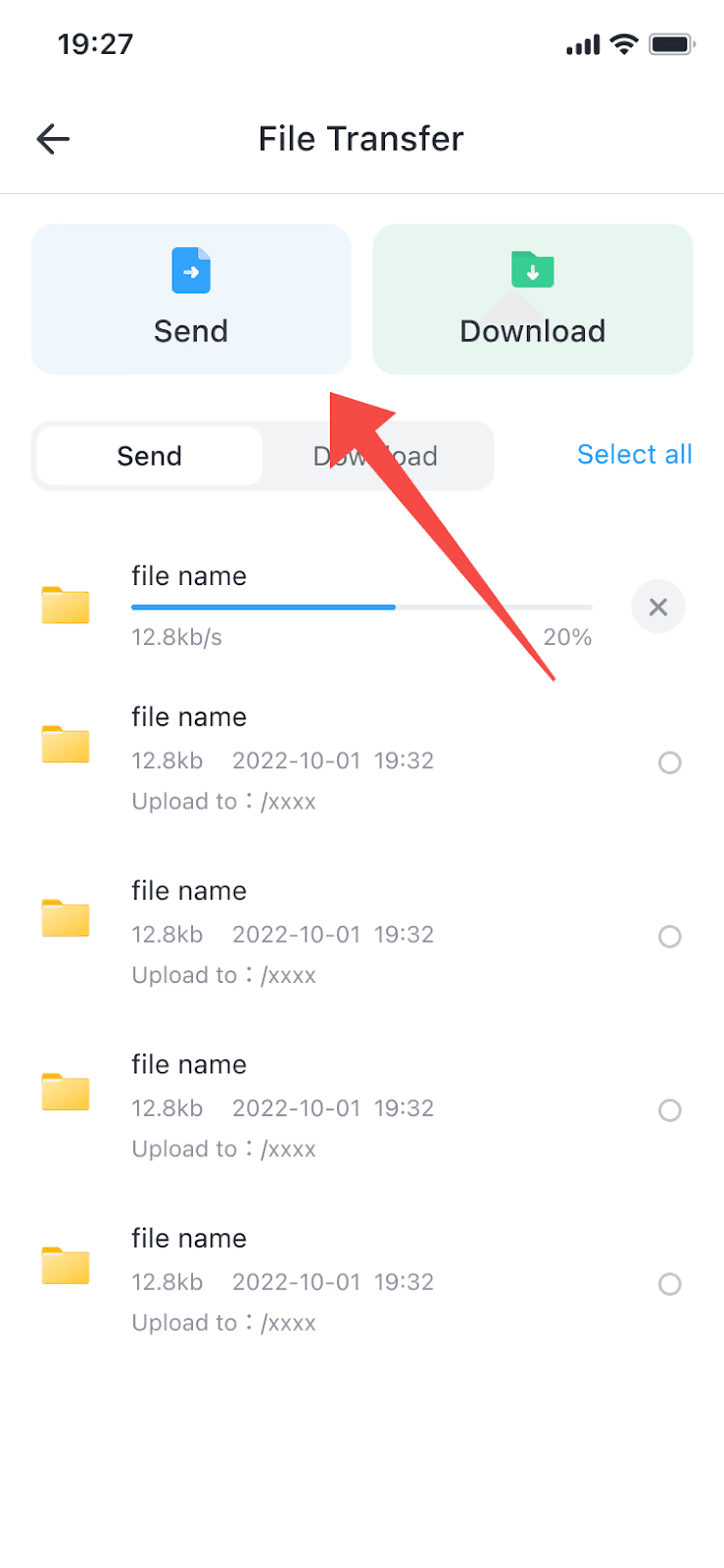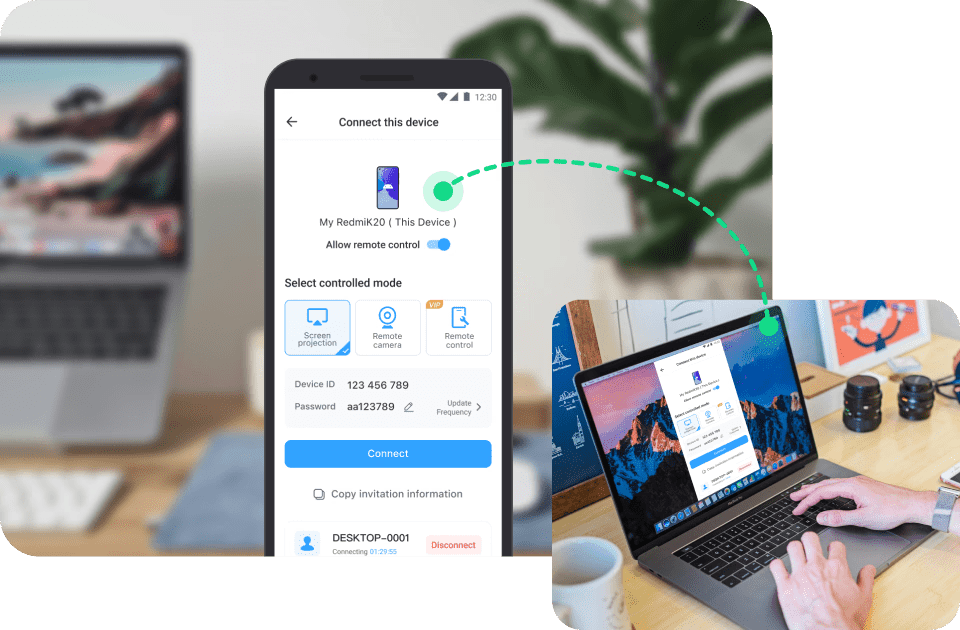Ever need to access your PC remotely but feel stuck? Maybe you want to control your home desktop from your laptop while traveling, access files from another room, or help elderly parents troubleshoot tech issues without confusing them. Setting up a secure, simple remote desktop connection solves these frustrations instantly.
But don't worry! This guide will walk you through 3 effective ways to get remote access to another computer, from built-in tools like the Remote Desktop Connection, online tools like Chrome Remote Desktop, to a more powerful alternative: DeskIn, an all-in-one remote access tool perfect for both personal and professional use!
Note: unlike traditional tools, DeskIn requires no port forwarding or system tweaks — perfect for users who want to get started right away. Get started by download the app!

1. Control Computer Remotely via Remote Desktop App [No Limits]
While both Remote Desktop Connection and Chrome Remote Desktop come up to your mind first when you need remote to computer, they come with limitations, like requiring the same network or missing advanced controls. If you're seeking more reliable, high-performance PC-to-PC remote access, DeskIn, the best secure remote desktop, offers a powerful and safe alternative.
DeskIn is an all-in-one remote desktop solution built for both personal and professional use. It works smoothly across Windows, macOS, iOS, and Android, and supports fast, low-latency connections, even over public networks. Whether you're working from home, managing office systems, or helping a family member, DeskIn makes the experience fast, intuitive, and secure.
You can start using DeskIn with a free trial. Just install, log in, and go.

Key Features of DeskIn:
No Cross-platform limit – Seamlessly works across Windows, macOS, iOS, and Android. You can remote access Windows from devices by DeskIn.
No network quality limit – Delivers smooth control with adaptive image optimization for various network conditions.
No Access modes limit – Choose between full control or view-only for secure support scenarios.
No screen-sharing monitor limit – Supports multi-monitor setups and real-time collaboration.
Effortless file transfer & clipboard sync – Quickly share files or copy-paste text between devices.
No complex setup needed – No port forwarding, firewall configuration, or VPN required.
Step 1. Download and install DeskIn
Download and install DeskIn on both the host PC and the device you'll use to control it.

Step 2. Log in or register for an account
Launch DeskIn and sign in with your account. If you're new, registration takes just a few seconds.

Step 3. Use the device ID and password to connect
After logging in on both devices, copy the "Device ID" and "password" from the target PC and paste them into the controller PC to establish the remote session.
Step 4. Remote access to another PC
Now, just click "Connect" on the host PC, and choose the remote control mode you need to begin the session. Start with the free version — DeskIn works out-of-the-box for most home and work use cases!


👀 Explore More Remote Control Options:
2. Connect to Another PC Using Remote Desktop Connection [No Installation]
If you're using a Windows PC and need to remote connect to another computer, the built-in Remote Desktop Connection (RDC) tool, re-named as Windows App, is one of the most reliable options, especially for those working within a Windows-based environment.
Remote Desktop Connection allows you to connect from one Windows machine to another over a network. Once connected, you can fully control the remote PC, access files, run applications, and perform administrative tasks as if you were sitting right in front of it. It's one of the best Windows remote control options for work-from-home professionals, IT support, or accessing a second device within your local network.
📌 Cons of Using Windows Remote Desktop Connection:
It only works on Windows Pro, Enterprise, or Education editions.
The host PC must stay on and online.
External access may require VPN or router configuration.
A bit complicated and time-consuming for beginners.
After learning the features and limits of Windows Remote Desktop Connection, now let's discover how to use it to remote desktop to another computer:
Step 1. On your PC, go to "Settings > System > Remote Desktop", toggle it on, and note the PC name.

Step 2. Click "Select users…" to add non-admin accounts if needed.
Step 3. Ensure the "Remote Desktop" is allowed in "Windows Defender Firewall" under allowed apps.
Step 4. Run the text "ipconfig" in "Command Prompt" and copy the "IPv4 Address".
Step 5. Open the Remote Desktop app (type "mstsc" in Run), enter the "PC name" or "IP", input credentials, and connect. If these steps feel too technical, or if you're using the Windows Home edition, consider a more intuitive alternative, like DeskIn — no VPNs, no IPs, just log in and connect.

You May Also Need:
3. Access Another PC via Chrome Remote Desktop [No Cost]
If you're looking for a quick, browser-based, and free way to remotely connect to another PC, Chrome Remote Desktop is one of the easiest options available. It runs entirely through the Chrome browser and works across Windows, macOS, Linux, and even mobile devices.
This tool is especially helpful for personal use, quick troubleshooting, or when you don't want to deal with complicated network setups. However, Chrome Remote Desktop's functionality is pretty basic and relies on a Google account. Need more than just screen control, but also features like file transfer, clipboard synchronization, or privacy screen? You might be better suited for method 1.
Step 1. On both the host and client computers, open the Chrome browser and visit "remotedesktop.google.com". Click "Access my computer", and install the Chrome Remote Desktop extension if prompted.

Step 2. On the PC you want to access, go to the "Remote Access" tab and click "Turn on". Choose a name for the computer and set a strong PIN code (at least 6 digits) for secure access.

Step 3. On the computer you're using to connect, visit the same website, sign in with the same Google account, and click on the device name listed under "Remote Devices." Enter the PIN to connect.

4. Remote to Computer by Apple Remote Desktop [Apple User]
For macOS users needing advanced tools to control a computer remotely, Apple Remote Desktop (ARD) offers robust features like automation, curtain mode, and multi-machine management. However, its $79.99 price tag lacks a free tier.
Note: If your budget is limited, you should consider the first method, DeskIn, whose free version provides powerful functions to satisfy your professional use.
STEP 1: Install ARD via Mac App Store ($79.99) and enable VNC on the target PC (Settings > System > Remote Desktop > Enable).
STEP 2: On your Mac, open ARD > "Add Computers" > enter the PC's "IP address or hostname".

STEP 3: Authenticate with the PC's username/password, then click "Control" to start remote access. Use "Curtain Mode" to hide the PC screen during sessions.
5. Get Remote Access to Another Computer by Quick Assist [Easy to Work]
Quick Assist, Microsoft's free built-in solution for Windows 10/11, lets you securely control remote computers in seconds—no downloads or tech expertise required. Perfect for guiding less tech-savvy users (like elderly parents), it lives in your Start Menu: just type "Quick Assist" and hit enter.
While a Microsoft account login is mandatory, the intuitive interface walks you through seamless screen sharing or full control. For instant, frictionless support sessions—from fixing settings to demonstrating tasks—this tool shines where paid alternatives overcomplicate.
Steps to Connect:
STEP 1: On your PC, search "Quick Assist" in Start Menu > Launch it > Sign in with your Microsoft account > Select "Give assistance".

STEP 2: Share the 6-digit security code with the user needing help (via phone/chat).

STEP 3: On the "remote PC", open Quick Assist > Enter the code > Click "Share screen".
STEP 4: Once connected, use the toolbar to take control of their PC or guide them.
7 More Tools to Remote Connect to Another PC
Beyond the five methods above, we'll briefly introduce 4 popular remote tools to broaden your toolkit for seamless remote connect to another PC. Each offers unique strengths for different scenarios.
4 Alternative Remote Access Tools:
RealVNC: This cross-platform solution delivers enterprise-grade security and supports file transfers, chat, and cloud connectivity.
Zoho Assist: Its browser-based access requires no installation, integrates with IT help desks, and offers session recording.
HelpWire: This tool is completely free for personal and commercial use, requires no downloads or registration, and supports dual-screen display.
TeamViewer: It allows setting permanent passwords, enables auto-start on boot for one-click connections, and includes team/zoom features for mouse control during video calls, though it's notorious for aggressive commercial-use detection and high subscription fees.
Tips for Secure and Efficient Remote Control PC to PC
Remote access offers convenience, but security and performance should always be top priorities. Here are some best practices.
Use strong passwords and 2FA: Always set strong, unique passwords for your remote tools and accounts. Whenever possible, enable 2FA to prevent unauthorized access even if your credentials are compromised.
Keep software updated: Outdated remote desktop software or OS versions can have unpatched vulnerabilities. Regularly check for updates on both the host and controller PCs to maintain optimal security and performance.
Choose a stable network: For consistent performance, connect both devices to a reliable internet source. Prefer wired Ethernet connections when available, or use strong Wi-Fi with minimal interference. Avoid public networks unless using a VPN.
Adjust resolution settings: Reduce resolution and disable animations when on a slow connection. Many remote desktop apps allow you to balance image quality and responsiveness for smoother interactions.
Limit access permissions: Only allow full control when absolutely necessary. Most tools support "view-only" or "ask for permission" modes—perfect for support scenarios. Also, disable unattended access if the device doesn’t need to stay permanently available.
Conclusion
Whether you're managing projects from home, helping a friend fix a PC issue, or accessing work files while traveling, remote access to another computer has become an essential part of daily life. From built-in tools like Windows Remote Desktop and Chrome Remote Desktop to more advanced platforms like DeskIn, you now have flexible options to stay connected anytime, anywhere.
However, if you need a more versatile, feature-rich, and user-friendly remote desktop tool to help you connect to another computer, DeskIn stands out. It removes technical barriers, supports a wide range of use cases from work to play, and includes great features like file transfer, screen mirroring, and 4K streaming. Ready to try it out? DeskIn is free to use and takes just a few minutes to set up — ideal whether you're a remote worker, IT helper, or casual user.

Ever need to access your PC remotely but feel stuck? Maybe you want to control your home desktop from your laptop while traveling, access files from another room, or help elderly parents troubleshoot tech issues without confusing them. Setting up a secure, simple remote desktop connection solves these frustrations instantly.
But don't worry! This guide will walk you through 3 effective ways to get remote access to another computer, from built-in tools like the Remote Desktop Connection, online tools like Chrome Remote Desktop, to a more powerful alternative: DeskIn, an all-in-one remote access tool perfect for both personal and professional use!
Note: unlike traditional tools, DeskIn requires no port forwarding or system tweaks — perfect for users who want to get started right away. Get started by download the app!

1. Control Computer Remotely via Remote Desktop App [No Limits]
While both Remote Desktop Connection and Chrome Remote Desktop come up to your mind first when you need remote to computer, they come with limitations, like requiring the same network or missing advanced controls. If you're seeking more reliable, high-performance PC-to-PC remote access, DeskIn, the best secure remote desktop, offers a powerful and safe alternative.
DeskIn is an all-in-one remote desktop solution built for both personal and professional use. It works smoothly across Windows, macOS, iOS, and Android, and supports fast, low-latency connections, even over public networks. Whether you're working from home, managing office systems, or helping a family member, DeskIn makes the experience fast, intuitive, and secure.
You can start using DeskIn with a free trial. Just install, log in, and go.

Key Features of DeskIn:
No Cross-platform limit – Seamlessly works across Windows, macOS, iOS, and Android. You can remote access Windows from devices by DeskIn.
No network quality limit – Delivers smooth control with adaptive image optimization for various network conditions.
No Access modes limit – Choose between full control or view-only for secure support scenarios.
No screen-sharing monitor limit – Supports multi-monitor setups and real-time collaboration.
Effortless file transfer & clipboard sync – Quickly share files or copy-paste text between devices.
No complex setup needed – No port forwarding, firewall configuration, or VPN required.
Step 1. Download and install DeskIn
Download and install DeskIn on both the host PC and the device you'll use to control it.

Step 2. Log in or register for an account
Launch DeskIn and sign in with your account. If you're new, registration takes just a few seconds.

Step 3. Use the device ID and password to connect
After logging in on both devices, copy the "Device ID" and "password" from the target PC and paste them into the controller PC to establish the remote session.
Step 4. Remote access to another PC
Now, just click "Connect" on the host PC, and choose the remote control mode you need to begin the session. Start with the free version — DeskIn works out-of-the-box for most home and work use cases!


👀 Explore More Remote Control Options:
2. Connect to Another PC Using Remote Desktop Connection [No Installation]
If you're using a Windows PC and need to remote connect to another computer, the built-in Remote Desktop Connection (RDC) tool, re-named as Windows App, is one of the most reliable options, especially for those working within a Windows-based environment.
Remote Desktop Connection allows you to connect from one Windows machine to another over a network. Once connected, you can fully control the remote PC, access files, run applications, and perform administrative tasks as if you were sitting right in front of it. It's one of the best Windows remote control options for work-from-home professionals, IT support, or accessing a second device within your local network.
📌 Cons of Using Windows Remote Desktop Connection:
It only works on Windows Pro, Enterprise, or Education editions.
The host PC must stay on and online.
External access may require VPN or router configuration.
A bit complicated and time-consuming for beginners.
After learning the features and limits of Windows Remote Desktop Connection, now let's discover how to use it to remote desktop to another computer:
Step 1. On your PC, go to "Settings > System > Remote Desktop", toggle it on, and note the PC name.

Step 2. Click "Select users…" to add non-admin accounts if needed.
Step 3. Ensure the "Remote Desktop" is allowed in "Windows Defender Firewall" under allowed apps.
Step 4. Run the text "ipconfig" in "Command Prompt" and copy the "IPv4 Address".
Step 5. Open the Remote Desktop app (type "mstsc" in Run), enter the "PC name" or "IP", input credentials, and connect. If these steps feel too technical, or if you're using the Windows Home edition, consider a more intuitive alternative, like DeskIn — no VPNs, no IPs, just log in and connect.

You May Also Need:
3. Access Another PC via Chrome Remote Desktop [No Cost]
If you're looking for a quick, browser-based, and free way to remotely connect to another PC, Chrome Remote Desktop is one of the easiest options available. It runs entirely through the Chrome browser and works across Windows, macOS, Linux, and even mobile devices.
This tool is especially helpful for personal use, quick troubleshooting, or when you don't want to deal with complicated network setups. However, Chrome Remote Desktop's functionality is pretty basic and relies on a Google account. Need more than just screen control, but also features like file transfer, clipboard synchronization, or privacy screen? You might be better suited for method 1.
Step 1. On both the host and client computers, open the Chrome browser and visit "remotedesktop.google.com". Click "Access my computer", and install the Chrome Remote Desktop extension if prompted.

Step 2. On the PC you want to access, go to the "Remote Access" tab and click "Turn on". Choose a name for the computer and set a strong PIN code (at least 6 digits) for secure access.

Step 3. On the computer you're using to connect, visit the same website, sign in with the same Google account, and click on the device name listed under "Remote Devices." Enter the PIN to connect.

4. Remote to Computer by Apple Remote Desktop [Apple User]
For macOS users needing advanced tools to control a computer remotely, Apple Remote Desktop (ARD) offers robust features like automation, curtain mode, and multi-machine management. However, its $79.99 price tag lacks a free tier.
Note: If your budget is limited, you should consider the first method, DeskIn, whose free version provides powerful functions to satisfy your professional use.
STEP 1: Install ARD via Mac App Store ($79.99) and enable VNC on the target PC (Settings > System > Remote Desktop > Enable).
STEP 2: On your Mac, open ARD > "Add Computers" > enter the PC's "IP address or hostname".

STEP 3: Authenticate with the PC's username/password, then click "Control" to start remote access. Use "Curtain Mode" to hide the PC screen during sessions.
5. Get Remote Access to Another Computer by Quick Assist [Easy to Work]
Quick Assist, Microsoft's free built-in solution for Windows 10/11, lets you securely control remote computers in seconds—no downloads or tech expertise required. Perfect for guiding less tech-savvy users (like elderly parents), it lives in your Start Menu: just type "Quick Assist" and hit enter.
While a Microsoft account login is mandatory, the intuitive interface walks you through seamless screen sharing or full control. For instant, frictionless support sessions—from fixing settings to demonstrating tasks—this tool shines where paid alternatives overcomplicate.
Steps to Connect:
STEP 1: On your PC, search "Quick Assist" in Start Menu > Launch it > Sign in with your Microsoft account > Select "Give assistance".

STEP 2: Share the 6-digit security code with the user needing help (via phone/chat).

STEP 3: On the "remote PC", open Quick Assist > Enter the code > Click "Share screen".
STEP 4: Once connected, use the toolbar to take control of their PC or guide them.
7 More Tools to Remote Connect to Another PC
Beyond the five methods above, we'll briefly introduce 4 popular remote tools to broaden your toolkit for seamless remote connect to another PC. Each offers unique strengths for different scenarios.
4 Alternative Remote Access Tools:
RealVNC: This cross-platform solution delivers enterprise-grade security and supports file transfers, chat, and cloud connectivity.
Zoho Assist: Its browser-based access requires no installation, integrates with IT help desks, and offers session recording.
HelpWire: This tool is completely free for personal and commercial use, requires no downloads or registration, and supports dual-screen display.
TeamViewer: It allows setting permanent passwords, enables auto-start on boot for one-click connections, and includes team/zoom features for mouse control during video calls, though it's notorious for aggressive commercial-use detection and high subscription fees.
Tips for Secure and Efficient Remote Control PC to PC
Remote access offers convenience, but security and performance should always be top priorities. Here are some best practices.
Use strong passwords and 2FA: Always set strong, unique passwords for your remote tools and accounts. Whenever possible, enable 2FA to prevent unauthorized access even if your credentials are compromised.
Keep software updated: Outdated remote desktop software or OS versions can have unpatched vulnerabilities. Regularly check for updates on both the host and controller PCs to maintain optimal security and performance.
Choose a stable network: For consistent performance, connect both devices to a reliable internet source. Prefer wired Ethernet connections when available, or use strong Wi-Fi with minimal interference. Avoid public networks unless using a VPN.
Adjust resolution settings: Reduce resolution and disable animations when on a slow connection. Many remote desktop apps allow you to balance image quality and responsiveness for smoother interactions.
Limit access permissions: Only allow full control when absolutely necessary. Most tools support "view-only" or "ask for permission" modes—perfect for support scenarios. Also, disable unattended access if the device doesn’t need to stay permanently available.
Conclusion
Whether you're managing projects from home, helping a friend fix a PC issue, or accessing work files while traveling, remote access to another computer has become an essential part of daily life. From built-in tools like Windows Remote Desktop and Chrome Remote Desktop to more advanced platforms like DeskIn, you now have flexible options to stay connected anytime, anywhere.
However, if you need a more versatile, feature-rich, and user-friendly remote desktop tool to help you connect to another computer, DeskIn stands out. It removes technical barriers, supports a wide range of use cases from work to play, and includes great features like file transfer, screen mirroring, and 4K streaming. Ready to try it out? DeskIn is free to use and takes just a few minutes to set up — ideal whether you're a remote worker, IT helper, or casual user.






